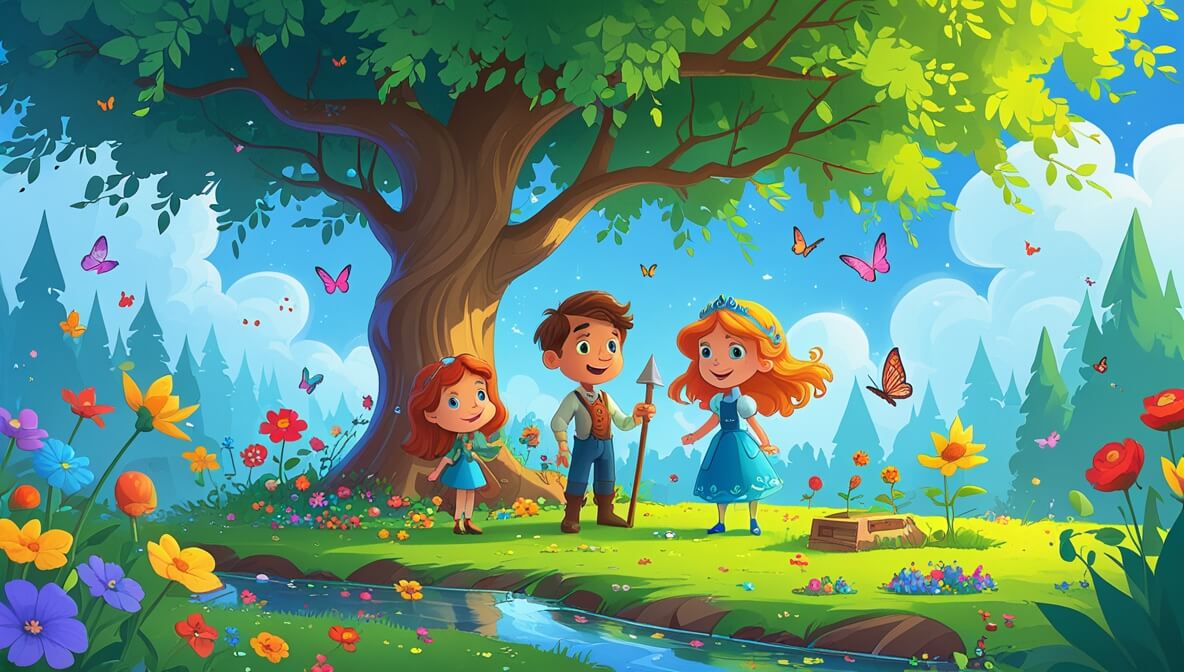A young princess discovers a magical garden hidden deep within the castle grounds, leading her on an unexpected adventure filled with enchantment and courage.
Age Recommendation
3 – 12 years
Characters
Characters:
- Princess Nia (a curious young princess with a love for adventure)
- Jasper the Gardener (the wise and kind keeper of the garden)
- Willow (a magical talking willow tree)
- Zara (a mischievous fairy who loves to play tricks)
Story
Once upon a time, in the kingdom of Eldergrove, there lived a young princess named Nia. Princess Nia was known for her adventurous spirit and her love for exploring the vast castle grounds. One sunny morning, while wandering through the courtyard, she noticed a narrow, winding path she had never seen before.
The Hidden Pathway
Curiosity piqued, Nia followed the path, which led her to a part of the castle gardens she never knew existed. Here, the air was filled with the sweet scent of blooming flowers, and the gentle sound of a babbling brook provided a soothing melody. In the center of this secret garden stood a majestic willow tree with branches swaying in the breeze.
The Garden’s Secret
As Nia approached, she was surprised to hear a gentle voice. “Hello, Princess Nia,” the willow tree spoke kindly. “I am Willow, the guardian of this enchanted garden.” Astonished yet delighted, Nia listened intently as Willow explained how the garden was a magical realm, hidden away from the rest of the world, and could only be discovered by those with a pure heart.
Meeting Jasper
Just then, an elderly man appeared, smiling warmly. “I see you’ve met Willow,” he said. “I am Jasper, the gardener. This garden holds many wonders and is home to many magical creatures.” With a twinkle in his eye, Jasper invited Nia to explore the garden further.
A Mischievous Encounter
As she wandered, Nia encountered Zara, a playful fairy who loved to play harmless tricks. Zara giggled as she made flowers dance and butterflies swirl around Nia. Though mischievous, Zara quickly became a friend, showing Nia hidden nooks and crannies filled with delightful surprises.
A Courageous Act
One day, while playing hide and seek with Zara, Nia noticed the sky growing dark. A fierce storm was approaching! The creatures of the garden began to panic. With determination, Nia and Zara worked together to guide the creatures to safety, using their combined wits and courage. With Willow’s guidance, they sheltered under his strong branches until the storm passed.
Returning Home
When the storm finally cleared, Nia knew it was time to return to the castle. With a heart full of new friendships and memories of courage, she promised to visit the enchanted garden as often as she could. The garden had taught her the true value of bravery and friendship, lessons she would carry with her forever.
The end.
Moral of the Story
The story teaches the value of courage and friendship. Even in the face of challenges, bravery and teamwork can help overcome the toughest obstacles. It also shows that exploring with an open heart can lead to unexpected and magical discoveries.
Questions to Think About
- What made Princess Nia’s adventure special?
- How did Nia show courage during the storm?
- What role did Willow and Zara play in the story?
- Why is friendship important in difficult times?
- What would you do if you found a magical garden?
Do You Know
- Willow trees are known for their graceful branches and can live for over 100 years.
- Fairies are often depicted in folklore as tiny, magical creatures with the ability to fly.
Word Explorer
- Majestic: Impressive and beautiful in a grand way.
- Enchanted: Filled with magic or wonder.
- Mischievous: Playful in a way that might be annoying but is not harmful.
Emotions in the Story
- Curiosity: When Nia discovered the hidden path, she felt curious about where it would lead.
- Surprise: Nia was surprised and delighted to hear Willow speak.
- Bravery: Nia felt brave when she helped the creatures during the storm.
Color Your Scene
Imagine the moment when Princess Nia sees the magical garden for the first time. Picture the colorful flowers, the gentle brook, and the majestic willow tree with its long, graceful branches. Use bright colors to bring this enchanted garden to life in your drawing.
Parents’ Corner
This story is a great way to talk to your child about:
- Courage: Discuss how Princess Nia showed bravery during the storm and what courage means in everyday life.
- Friendship: Talk about the importance of having friends like Zara and how they can support each other.
- Curiosity and Exploration: Encourage your child to be curious and explore their surroundings, fostering a love for learning and discovery.
- Problem-solving: Highlight how Nia and Zara worked together to solve the problem of the approaching storm.











